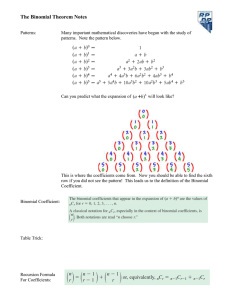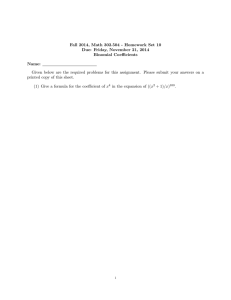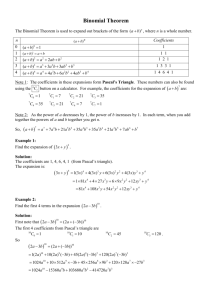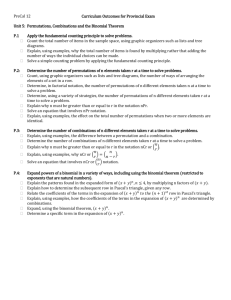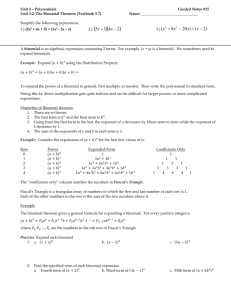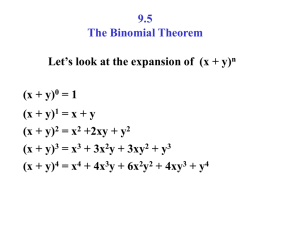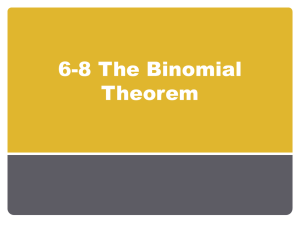Module 9 Lesson 4 The Binomial Theorem Notes
advertisement
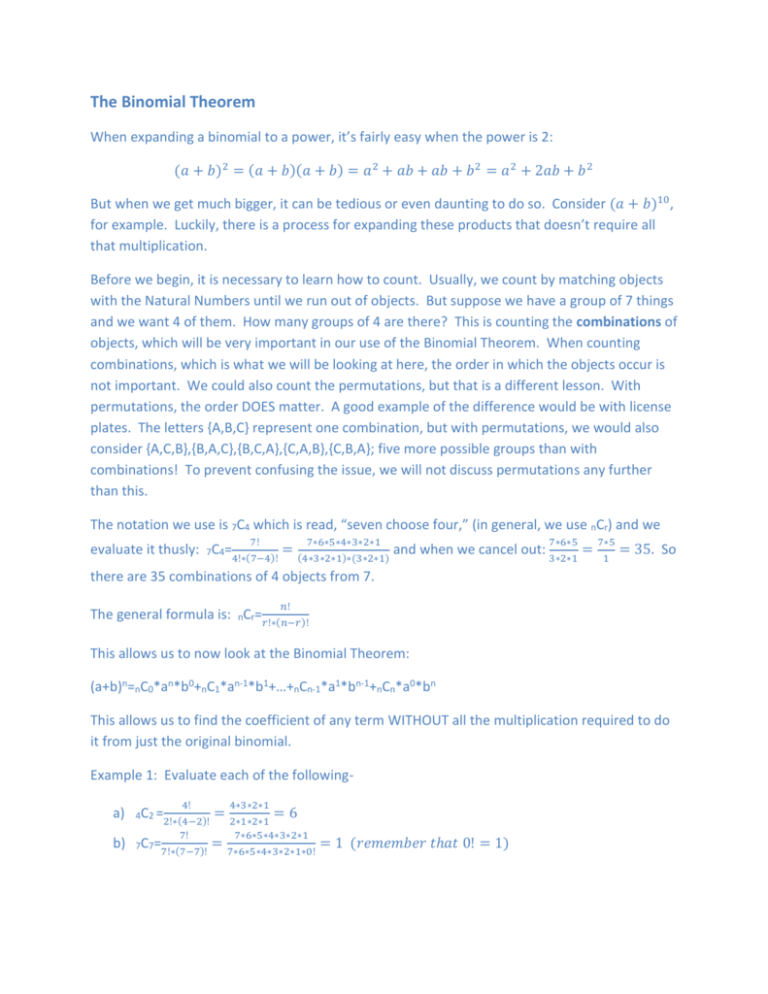
The Binomial Theorem
When expanding a binomial to a power, it’s fairly easy when the power is 2:
(𝑎 + 𝑏)2 = (𝑎 + 𝑏)(𝑎 + 𝑏) = 𝑎2 + 𝑎𝑏 + 𝑎𝑏 + 𝑏 2 = 𝑎2 + 2𝑎𝑏 + 𝑏 2
But when we get much bigger, it can be tedious or even daunting to do so. Consider (𝑎 + 𝑏)10,
for example. Luckily, there is a process for expanding these products that doesn’t require all
that multiplication.
Before we begin, it is necessary to learn how to count. Usually, we count by matching objects
with the Natural Numbers until we run out of objects. But suppose we have a group of 7 things
and we want 4 of them. How many groups of 4 are there? This is counting the combinations of
objects, which will be very important in our use of the Binomial Theorem. When counting
combinations, which is what we will be looking at here, the order in which the objects occur is
not important. We could also count the permutations, but that is a different lesson. With
permutations, the order DOES matter. A good example of the difference would be with license
plates. The letters {A,B,C} represent one combination, but with permutations, we would also
consider {A,C,B},{B,A,C},{B,C,A},{C,A,B},{C,B,A}; five more possible groups than with
combinations! To prevent confusing the issue, we will not discuss permutations any further
than this.
The notation we use is 7C4 which is read, “seven choose four,” (in general, we use nCr) and we
7!
7∗6∗5∗4∗3∗2∗1
7∗6∗5
evaluate it thusly: 7C4=4!∗(7−4)! = (4∗3∗2∗1)∗(3∗2∗1) and when we cancel out: 3∗2∗1 =
7∗5
1
= 35. So
there are 35 combinations of 4 objects from 7.
𝑛!
The general formula is: nCr=𝑟!∗(𝑛−𝑟)!
This allows us to now look at the Binomial Theorem:
(a+b)n=nC0*an*b0+nC1*an-1*b1+…+nCn-1*a1*bn-1+nCn*a0*bn
This allows us to find the coefficient of any term WITHOUT all the multiplication required to do
it from just the original binomial.
Example 1: Evaluate each of the followinga)
4C2 =
b)
7C7=
4!
2!∗(4−2)!
7!
7!∗(7−7)!
4∗3∗2∗1
= 2∗1∗2∗1 = 6
7∗6∗5∗4∗3∗2∗1
= 7∗6∗5∗4∗3∗2∗1∗0! = 1 (𝑟𝑒𝑚𝑒𝑚𝑏𝑒𝑟 𝑡ℎ𝑎𝑡 0! = 1)
c)
7C0=
7!
7!
= 7! = 1 (Notice that there are exactly as many ways to choose all and
0!∗(7−0)!
none)
d)
e)
25!
25C15=
15!∗(25−15)!
5∗23∗22∗19∗2∗17∗2)
nCn=
1
𝑛!
=
25∗24∗23∗22∗21∗20∗19∗18∗17∗16∗15!
15!∗10!
=
25∗24∗23∗22∗21∗20∗19∗18∗17∗16
10∗9∗8∗7∗6∗5∗4∗3∗2∗1
=
= 3,268,760
𝑛!
= 𝑛! = 1
𝑛!∗(𝑛−𝑛)!
Example 2: For each of the following, find the requested term.
a) Find the 4th term of (x+3)9. The first thing to do is be sure which term is the 4 th. The 4th
term will be the one with x6. So our term will be: 9C3*x6*33=84*x6*27=2268x6.
b) Find the last term of (2x-4)7. This one is a little tricky- note that we must use -4 for our
‘b’ value here. So our last term will be: 7C7*(2x)0*(-4)7=1*1*(-16384)=-16384.
c) Find the 7th term of (3x-2)11. So our term will be: 11C6*(3x)5*(-2)6=462*(243x5)*64=
7185024x5. SO much easier than multiplying it out!
Pascal’s Triangle
The Binomial Theorem is great, but can be a little tedious. For a quicker way to find the
coefficients, we have Pascal’s Triangle, which takes a different approach to finding the
coefficients. It looks like this:
1
1 1
1
1
1
4
2 1
3
3
6
1
4
1
etc.
The method to generate the triangle is to start with a 1. The second row is just two 1s. For the
third and all subsequent rows, start and end with a 1. Each term between the ones is the sum
of the two numbers above it. The second number tells you the power of expansion that the
coefficients relate to. So the last row above is for (a+b)4, and to go beyond that you just
continue the pattern!
Example 2: Expand (2x+3)4
This will use the fourth row of Pascal’s triangle, so our coefficients will be {1,4,6,4,1}. Our first
term is 2x and our second is 3. With this in hand, we can write:
(2x+3)4 = 1(2x)4(3)0+4(2x)3(3)1+6(2x)2(3)2+4(2x)1(3)3+1(2x)0(3)4
=1(16x4)(1)+4(8x3)(3)+6(4x2)(9)+4(2x)(27)+1(1)(81)
=16x4+96x3+216x2+216x+81
And there you have it! LOTS quicker than doing all that multiplication piecemeal!

